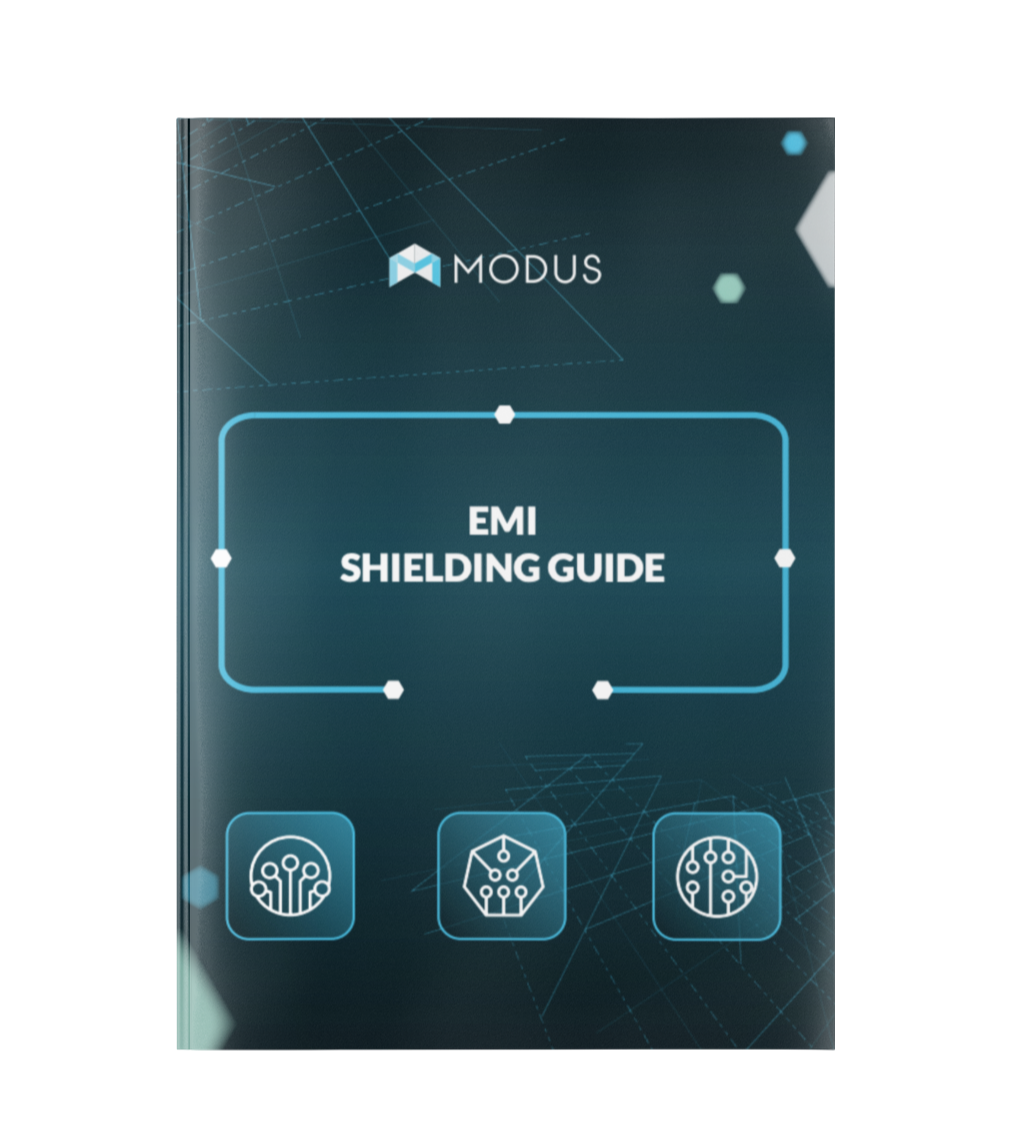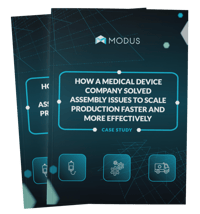EMI Shielding Guide
The team at Modus Advanced has put together this guide to EMI shielding to help you understand how to select materials and design for EMI shielding applications.
Or scroll to read the entire guide below.

Introduction
EMI shielding in electronic devices and equipment is the use of manufacturing techniques and materials to protect signals from being disrupted by external electromagnetic signals as well as preventing generated signals from interfering with surrounding components. Essentially, EMI shielding serves to block these signals from entering or exiting a portion of a part or product.
Electromagnetic interference (EMI) can disrupt electronic devices, equipment, and systems that are used in critical applications. Examples include medical, military, and aerospace electronics; mass transit systems; industrial touch screens; and navigation and vehicular control systems - just to name a few.
The causes of electromagnetic interference, often simply referred to as “noise,” are numerous, and include both man-made and natural sources.
The issues this interference can cause to the function of a part or product can range from temporary disturbances and data losses to system failure and even loss of life.
That relatively simple definition boils down what amounts to an extremely complex — and critically important — concept in engineering. The endeavor to create effective EMI shields and incorporate them into the designs of susceptible electronic devices requires extreme precision and thoughtful engineering. Highly experienced in this field, the team at Modus Advanced has put together this guide to EMI shielding to help you understand EMI shielding and how to fit it into your designs.
To learn more, keep reading. To get expert design feedback, engineering guidance and manufacturing help, reach out to Modus Advanced.
Table of Contents
What Is an EMI Shielding Gasket?
EMI gaskets are electrically conductive materials that cover openings, doors and seams in electronic devices to stop interfering signals from entering those devices. This prevents interference with internal components that can receive or transmit electromagnetic signals.
EMI shielding gaskets were once relatively rare outside of defense and radio communication applications. However, with the explosion of consumer devices that utilize or can be affected by electromagnetic signals, EMI gaskets have experienced something of a renaissance in a wide variety of industries.
EMI vs. RFI Shielding
In discussions of EMI and how to protect electronic devices from it, you often hear the term “RFI” thrown in as if it is interchangeable with EMI. The two terms refer to different types of signals that could interfere with sensitive electronic devices, but in most cases, if you need to protect a device from one, you need to protect that same device from the other.
RFI stands for “radio frequency interference.” These signals are simply electrical signals that occupy some point in the range of frequencies used for radio transmission. In general, RFI signals are a form of EMI, and as a category EMI encompasses a much larger range of signals than just RFI. The materials used to protect devices from EMI signals will, in most cases, cover RFI signals.
Where EMI Comes From
EMI can come from a large variety of sources. Many of those sources are the result of man-made devices, but some result from natural phenomena. The following are some common man-made sources of EMI:
- Cellular networks
- WiFi networks
- Cellular devices
- Ignition systems
- Power lines
- Microwave equipment
- High-frequency devices
- Computers and similar devices
The ubiquity of these man-made sources of EMI already makes these harmful signals a big problem for sensitive devices, but even before these technologies existed, natural events were emitting plenty of electromagnetic signals that can interfere with electronic devices. Here are some examples of those natural events:
- Lightning
- Auroras
- Solar flares
The sources of EMI may vary widely, but their effect on sensitive devices is often similar.
Conducted vs. Radiated EMI
Electromagnetic signals can reach a device in two key ways:
- Conduction
- Radiation
Conducted EMI
Conducted EMI passes through a conductive surface to reach a device connected to that surface. The most common conductive surfaces that promote conducted EMI are power and transmission lines.
However, poor grounding can contribute to the spread of conducted EMI. When a transmission line is poorly grounded, signals can leak out and reach alternating current (AC) lines. These signals can then travel to and interfere with devices connected to the AC line.
Radiated EMI
Radiated EMI reaches devices without the benefit of a clear path to follow to reach sensitive devices. An EMI source, such as a cellular network or lightning strike, wirelessly emits these signals, which travel through space to reach a victim.
Radiated EMI can occur on a large scale, across miles of space between disparate electronic sources, or on a small scale. An example of smaller-scale radiated EMI is a signal jumping from one wire to another inside a cable. This type of interference is usually the result of the magnetic field inherent in closed-loop circuits inducing a signal into a nearby circuit.
For purposes of EMI shielding gaskets, the discussion typically focuses on far-field interference, which involves the blocking of electromagnetic radio waves over longer distances.
How EMI Can Interfere with Electronic Devices
As the sources of EMI become even more widespread throughout modern society, the impact of EMI on unprotected devices will likely grow larger. But how, exactly, does an electromagnetic signal interfere with a sensitive device?
For EMI to affect an electronic device, it must have three key components:
- A source
- A path
- A receptor
The source is the electronic circuit or device that provides the initial signal. The path is the electromagnetic field, conductor or similar medium along which the interfering signal will travel. And the receptor is the device that will suffer as a result of exposure to the unwanted electromagnetic signal.
How the receptor device suffers from EMI can vary, but in most cases, the problems will involve degraded or completely lost data along the device’s circuits. In telecommunications, this could look like interrupted audio. In defense and military applications, this could look like satellites that cannot properly send or receive the data and signals required for them to complete their intended functions.
The examples of EMI interference in various industries are numerous, but the end result is reduced performance. Sometimes, that reduction in performance can result in millions of dollars lost on failed technologies or even lives being put at risk in high-impact military and defense situations.
Applications for EMI Shielding
Over time, EMI shielding gaskets have seen their applications spread from a couple of relatively small industries to span dozens of industries across the government, military, industrial and consumer markets. In the section below, we examine the applications of EMI shielding in some of the industries that most commonly use this technology today.
These industries include the following:
- Defense and aerospace
- IT and telecom
- Medical devices
- Mass transit
- Industrial equipment
- Automotive
- Consumer electronics
 Defense and Aerospace
Defense and Aerospace
In industries like defense and aerospace, EMI shielding can quickly become a question of life and death. Using satellites and GPS beacons to, for example, locate survivors of natural disasters, warfare and other deadly situations requires extreme precision. EMI is the killer of such precision.
Accidental malfunction due to EMI is only one part of the equation in aerospace and defense. Actors within these industries must also account for the potential of targeted EMI attacks on critical devices, such as satellites, fighter jets and radar systems. Because of the severity of the effects of EMI-related malfunctions in these spaces, EMI gaskets have become a fixture on devices and vehicles for defense and aerospace applications.
 IT and Telecom
IT and Telecom
By the middle of the 2010s, finding a home or business that did not have an internet router would have been an enormous challenge. These devices are sensitive to the effects of EMI, but they aren’t the only such devices in the IT and telecommunications markets. Photocopiers, fax machines, servers, ethernet switches and similar devices can all benefit from EMI shielding.
 Medical Devices
Medical Devices
Many devices used in medical settings are susceptible to EMI. This realization and the resulting increase in federal oversight of medical devices’ electromagnetic compatibility has led to expanded investment in EMI shielding in healthcare.
One key example of the problems unmitigated EMI can cause in a medical setting is the cardiac pacemaker. This issue has been of concern since the 1960s, according to the U.S. Food and Drug Administration. Everything from magnetic resonance imaging (MRI) to cell phones may interfere with cardiac pacemakers. When interference prevents a pacemaker from operating properly, the device may not signal the patient’s heart to beat when it should, increasing the probability of a heart attack, stroke or similar life-threatening cardiac issue.
Other examples of medical devices that can suffer from EMI include the following:
- Electronic devices used in surgeries
- X-ray imaging devices
- Infusion pumps, ventilators and other devices used for life support
EMI shielding is, of course, one of the key methods of preventing electromagnetic interference with critical medical devices.
 Mass Transit
Mass Transit
Functions that are essential to the operation of mass transit systems may produce their own electromagnetic signals, which can then cross-contaminate other essential functions within the system. Systems used to propel, signal and control trains, for example, may use high voltages that spark their own electromagnetic signals, and they may be similarly susceptible to interference by competing electromagnetic signals.
Efficiency, safety and precision are key considerations in any mass transit environment, so protecting these systems from EMI is critical.
 Industrial Equipment
Industrial Equipment
In industrial settings, technology is a key driver of increased profitability, efficiency and safety. Factories, warehouses, distribution centers and similar facilities increasingly rely on sensitive and complex electronic devices and systems to get their everyday work done.
What happens when these devices experience EMI is clear: data is lost, systems are interrupted and productivity comes to a halt. The investment in EMI shielding for industrial devices is one that can pay off in a big way.
 Automotive
Automotive
Technological advances in the automotive industry have brought with them an increase in EMI density in both private and commercial vehicles. Consider some of the newer elements of a high-end vehicle sold today: electric motors, remote starters, in-vehicle WiFi, onboard GPS, wireless phone chargers, automatic sliding doors and keyless ignitions. All of these convenient and attractive technologies are susceptible to EMI, and many of them can produce rogue signals of their own.
 Consumer Electronics
Consumer Electronics
Over the long term, it is easy to see that consumer electronics have become more common, but one in particular, the smartphone, has contributed more to the potential of EMI than almost any other invention. That is because smartphones operate on common EMI pathways like WiFi and cellular networks, and they have consolidated a number of separate electronic devices that were much less likely to emit and suffer from rogue electromagnetic signals.
Consumers once had separate digital cameras, GPS devices, personal music players, computers and even flashlights. Now, most smartphones can take the place of all of those devices at once, and consumers have bought into this technology in a big way. More than 85% of Americans now own smartphones, and that number is rising in markets around the world.
The result is a sharp increase in the potential for EMI, meaning the usefulness of EMI gaskets in a wide variety of devices that could be affected has grown in a similar manner.
EMI Shielding Materials
Understanding that you need an EMI shielding gasket in your design is step one. Step two is determining the materials you will need to use to create that gasket. This second step is critical to the effectiveness and total cost of your design.
That is why you need to devote considerable time to choosing your EMI gasket materials in the design phase. Deciding on materials early in the process prevents expensive redesigns and potential problems with the ultimate product.
A wide range of materials can be used in EMI gaskets, but they can be broken down into two categories: filler materials and base materials. Below, we explore the material options you have within these categories, as well as some important considerations as you narrow down your options.
Understanding Military Specifications for Conductive EMI Gaskets
The U.S. Department of Defense sets standards for various materials that must be met if those materials are meant to be used for defense or military applications. Because EMI gaskets are common components in satellites, sensitive communications equipment and various other technologies that might have defense applications, the military specifications (MIL-SPEC) for electrically conductive EMI gasket materials are an important consideration in many cases.
Specifically, the MIL-G-83528/MIL-DTL-83528 specification governs quality standards for EMI gasket materials. We have noted the MIL-SPEC type definitions for each filler material listed below.
Filler Materials
The filler materials in an EMI gasket lend the device its electrical conductivity and EMI shielding properties. Without an effective filler material, a standard silicone gasket could allow an electromagnetic signal to pass right through.
The options for EMI gasket filler materials are limited to those that can actually prevent interfering signals from entering a device and promote electrical conductivity along the host device. Some filler materials are available only with particular base materials, but the standard filler material options include the following:
- Silver (defined as Type E in MIL-G-83528)
- Silver copper (defined as Type A (65A) and Type K (85A) in MIL-G-83528)
- Silver nickel (defined as Type L in MIL-G-83528)
- Silver aluminum (defined as Type B and Type D fluorosilicone in MIL-G-83528)
- Nickel graphite
- Nickel aluminum (one of the best choices to avoid corrosion)
Each of these gasket filler materials comes with its own unique properties and price point. In other words, some of these fillers will only be compatible with particular devices and budgets.
Base Materials
The other major choice you will have to make when selecting materials for your EMI gasket involves the base of the gasket — the material that surrounds the filler and effectively plugs the opening you are trying to cover in your design. The materials used for EMI gaskets overlap with many of the common materials used with non-EMI shielding, standard gaskets.
Silicone
Silicone is a widely available, affordable and common gasket material, and it’s often found in EMI gaskets. Because of its high degree of flexibility and easy cutting, silicone can be used in a wide variety of gasket applications and made conductive by an appropriate filler material.
However, exposure to oil, fuel, sunlight and corrosive chemicals can degrade silicone relatively quickly. Degradation of the silicone in an EMI gasket can compromise the gasket’s ability to shield its device from EMI, as well as reducing the sealing capabilities of the gasket as a whole.
For that reason, silicone EMI gaskets are most typically used in connector ports inside electronics or on circuit boards. Filler materials used in silicone EMI gaskets typically include silver, aluminum, nickel and copper.
Fluorosilicone
Fluorosilicone solves many of the problems a silicone gasket might encounter in harsh conditions.
Although it is more resistant to harsh environments than silicone, fluorosilicone is still commonly found in internal circuit board applications. This material is often paired with the same fillers as silicone: silver, aluminum, nickel and copper.
Ethylene Propylene Diene Monomer (EPDM)
EPDM is a synthetic rubber that brings high resistance to environmental factors. This material is much more resistant to caustic chemicals like acetones, hydrocarbons and detergents.
This resistance to corrosion and chemical exposure is checked, however, by a lower resistance to high temperatures when compared to silicone and fluorosilicone, as well as poor resistance to oil exposure.
Foam and Fabric Over Foam
This type of gasket material departs from the standard method for introducing conductivity. Instead of filling the gasket with a conductive metal, engineers spray polyurethane foam with nickel or copper to make it conductive. In some cases, a foam-based EMI gasket will have a fabric or wire mesh placed over it.
This style of EMI gasket is only compatible with low closure force environments. Also, keep in mind that, while most EMI gaskets do not provide a strong environmental seal, this style may be particularly vulnerable to water and similar exposures.
Beryllium Copper
Beryllium copper is a high-performance metal that can be fabricated in a variety of shapes. If your design involves repetitive opening and closing of the opening the gasket will cover, beryllium copper may be a good option because it has a high compression set. This metal protects against a wide range of signal frequencies and does not require a filler material like silver or nickel graphite.
Considerations for Choosing EMI Gasket Materials
Form, function and cost are the key considerations you should have in mind as you choose your EMI gasket materials. Often, as you adjust for one factor, another factor becomes more difficult to deal with. In other words, you will have to commit to a balancing act as you choose your materials.
For example, if you are set on silver as the filler for your gasket, prepare to pay high prices because this is the most expensive filler. You may then want to adjust by choosing a lower-cost base material to stay within budget. Below, we look at some of the other key considerations when choosing EMI gasket materials.
Form-in-Place Gasket Materials
There are instances where you’ll have either small, intricate gaskets or the need for a three dimensional gasket rather than a two dimensional gasket made from a single sheet of material. Form-in-place gaskets and extrusions are often the two choices to fill this need.
When in this situation, one of the first questions you should ask yourself and answer when designing an EMI gasket is whether you are going to go with a form-in-place (FIP) gasket or an extrusion. An FIP gasket is dispensed directly onto a part as a liquid so that it forms a seal that fits the exact specifications of the housing, making up for any imperfections on the housing.
The chief benefit of an FIP EMI gasket is that it reduces waste. The gasket is bonded to the surface of the housing and fits it exactly, so there is no cutting or adjusting that leaves expensive EMI materials on the floor. Additionally, if your gasket needs to take a highly complex or intricate shape or fill a very small space, FIP is likely to be the solution you need.
Cost and reduced waste are enormous benefits of FIP gaskets for EMI applications, but a real drawback can materialize if you need your gasket to both protect against EMI and provide a reliable environmental seal. In almost all cases, an FIP gasket can do a good job of only one of those applications — not both.
Extrusion Gasket Materials
Extrusion gaskets are created by feeding the gasket material through a die. The material is dispensed in the appropriate shape to fit the design, but someone must still cut it to the appropriate length, apply it to the housing and bond the two ends together to complete the seal.
Some extrusion gaskets can do a good job of both EMI shielding and environmental sealing. These gaskets also typically perform better in scenarios where the hole must be reopened frequently — they are more likely to “re-bind” and create an effective seal upon closure.
However, this method of EMI gasket production can lead to more waste when you are cutting the gasket material to fit the specifications of your design, and it adds a step to the assembly process. Instead of dispensing the gasket directly into the housing and letting it cure as you would in FIP, you must actually apply the extruded gasket to the device.
Importance of Working with an Expert
The properties and manufacturing processes involved with each EMI shielding gasket material are different, and sometimes the interactions between gasket material, filler and housing can be hard to predict. In other cases, you may choose materials that are unnecessarily expensive or design a gasket that is unnecessarily large.
These kinds of setbacks can cause it to take significantly longer to manufacture your final product, completely sink a design, or make it impossible to produce on any kind of larger scale. That is why so many engineers and designers turn to an EMI shielding expert when designing their EMI gaskets. The expert team at Modus Advanced encourages designers to get them involved early in the design phase to allow for feedback and recommendations before too much has been invested in a design that ultimately won’t work the way it should.
Manufacturing Processes for EMI Shielding Gaskets
The process you choose to manufacture your EMI gasket is as important to the design as the materials you choose. Manufacturers approach EMI shielding gaskets in a variety of ways, but six of the most common ways to manufacture these gaskets include the following:
2. Waterjet cutting
4. Form-in-place (FIP)
6. Molding
Below, we go into more detail about each of these processes.
Die-Cut EMI Shielding Gaskets
Die-cutting is a relatively simple and easily repeatable process that can cut through sheets of low-resistance gasket materials quickly and precisely. A die is attached to a machine that guides the die through the material — typically silicone for EMI gaskets produced via die-cutting — to meet the specifications of the design.
This process is fast. Usually, the start-to-finish process of die-cutting EMI gaskets takes between two and four weeks. This is due in part to the wide availability of die-cutting machinery and facilities, as well as manufacturers who can do die-cutting well.
Waterjet-Cut EMI Shielding Gaskets
Manufacturing EMI gaskets via waterjet cutting can be ideal for projects that require a quick turnaround, precise corners and hard materials. The process is relatively simple: water under extremely high pressure mixes with a grit like garnet sand and fires at the material that needs to be cut.
This process requires no hard tooling, so it can be done relatively quickly. Due to the high degree of precision involved in this process, material waste is usually reduced in reference to other methods, such as die-cutting.
CNC and Digital Cutting of EMI Shielding Gaskets
To do computer numerical control (CNC) cutting, a manufacturer pre-programs software that controls the movements of the cutting equipment. These machines can handle complex 3D cutting jobs, making them useful for producing relatively complex EMI gaskets.
Because this process does not rely on hard tooling, it is ideal when you need to rapidly create a prototype without spending too much of your budget. Digital precision enables CNC machinery to take on both large and very small, intricate parts.
FIP EMI Shielding Gaskets
Covered in the previous section, the FIP process is much like molding but with one key difference. Instead of dispensing the liquid gasket material into a mold, the material is dispensed directly onto the housing it is meant for. Allowing the gasket material to cure on and bond to the substrate eliminates the need for adhesive during assembly, as well as the assembly process itself.
FIP EMI gaskets are often ideal for intricate or very small gasket designs. This gasket manufacturing process also eliminates virtually all material waste.
Extruded EMI Shielding Gaskets
The extrusion process, which we covered in the previous section, is a good fit for gaskets that must fit particular flanges and grooves. Solid and hollow O shapes, solid and hollow squares and hollow D, P, E and U profiles typical of this gasket manufacturing process work well in many EMI applications. The ability to add an outer layer of conductive silicone reduces the necessary volume of expensive filling materials, making this process economical in a variety of use cases.
However, keep in mind that extruded gaskets ask something extra of the assembly process. After curing, the extruded gaskets must be cut, spliced and bonded together at the ends.
Molded EMI Shielding Gaskets
A molded EMI shielding gasket is what it sounds like: it is a gasket that was dispensed into a mold made to reflect the exact specifications of your design. This method is especially handy when you are using irregular profiles or intricate gasket pathways that would not be appropriate for die cutting or extrusion. Using a precise mold also reduces material waste — often a key consideration when costly filler materials are involved in a gasket design.
However, the benefits of molding for EMI gaskets garner this method a higher production cost, so keep that in mind as you plan your gasket manufacturing specifications.
SigShield™: Vertical Integration to Save Time and Headaches
We have discussed the typical processes used to manufacture EMI gaskets, but we don’t want to neglect the fact that this is only one part of the process. If you are building an EMI gasket, you more than likely will also need to produce metal housing and related parts. And there’s nothing less efficient than separating the design and manufacturing of all of these related parts by working with multiple companies to get them done. That’s why Modus developed SigShield™.
We have broken the SigShield™ process down into four key steps:
2. Applying platings and coatings
4. Manufacturing and applying microwave absorbers and thermal materials
The result of putting all of those processes under the same roof is a 50% reduction in typical lead times. You also get to save on freight costs — instead of paying to have your part shipped to you four different times, you have it shipped once at the end of the process.
The EMI Gasket Production Process: From Design to Manufacturing
Armed with everything you need to know about EMI shielding and EMI gaskets, you are ready to take the EMI gasket production process from start to finish. We have outlined the phases in this process below, breaking it down into five major steps:
2. Choosing an EMI gasket material
3. Prototyping of EMI gaskets
4. Finding a manufacturing partner
5. Shifting to long-term EMI shield production
Your manufacturing partner will be an essential part of every single one of these steps. Read on to learn more.
1. Designing an EMI Gasket
The design phase of your EMI gasket lays the groundwork for the overall success of the project. Mistakes and oversights here can lead to unnecessary expenses, project delays and ineffective final products. Ensuring easy and affordable manufacturability is key, but this is often an area where even the most experienced designers can fall short.
Often, over-design is the culprit in manufacturability failures. Making the gasket unnecessarily intricate, using grooves instead of flat surfaces when you don’t need them and designing it to be too large can lead not only to production problems but extremely high costs. This is why it is so important to get your manufacturing partner involved as early as possible in the design phase.
Teamed up with Modus Advanced or another partner, you should consider the following factors during the design phase of gasket production:
- How easy or hard it will be to manufacture the design
- The method of manufacturing that will fit both the design and budget
- The environment your EMI gasket will be in
- The properties the gasket will need to have in order to withstand that environment
- Whether the gasket must serve functions other than EMI shielding, such as creating an environmental seal
- The laws and rules that are applicable to your design and whether your design will meet them
The Modus team can provide feedback on all of these considerations, as well as guidance to make your design more effective, more efficient and less expensive.
2. Choosing an EMI Gasket Material
As our earlier EMI Shielding Materials section makes clear, you have a wide variety of material options for your gasket. Often, this is a part of the production process that presents some serious challenges — designers are unable to decide which material will be best.
To help, consider the following factors, how important they are and the materials that will best address them:
- Whether the gasket will be exposed to the elements
- The temperature ranges the gasket will face in its real-life application
- The severity of the forces that will be applied to the gasket
- The material of the gasket’s housing and the metals it might interact with to cause corrosion
- The chemicals the gasket may come into contact with
- The size of the EMI gasket
- The size and shape of the gasket
- Whether outgassing can cause problems in your design
In many cases, a gasket production partner like Modus Advanced can provide insights into materials that in-house teams may not immediately think of. With hundreds of similar projects under our belts, we have seen what does and does not work in particular applications. That insight can prove invaluable in the production of sensitive and critical EMI gaskets.
3. Prototyping of EMI Gaskets
The prototype phase is about as exciting as it gets in EMI gasket production. This is the part when you produce a real, functional version of your gasket to test it and assess its quality. Expect to make many small changes to the design during this phase, and expect to use a relatively large amount of materials to test each of the small refinements you will make.
Without proper planning and a talented manufacturing partner, prototyping can quickly become expensive and frustrating. But the right partner — one who can provide design feedback, a wide variety of test materials, quick turnaround times and low-cost prototype manufacturing — can make this part of the process much easier.
Well before you have reached the long-term production phase, you will need to consider the manufacturing process that will fit the specific needs of the prototyping phase. Paying for hard tooling to produce prototypes that will likely undergo many design changes is usually not cost-effective. Instead, you will most likely want to go with an easily reconfigurable and less expensive manufacturing process for your prototypes. Examples include digital, CNC and waterjet gasket cutting.
 How Rapid Prototyping Solved Assembly Issues for a Medical Device Company
How Rapid Prototyping Solved Assembly Issues for a Medical Device Company
4. Finding a Manufacturing Partner
With the prototype phase over and the final design approved, you are ready to move into manufacturing your gasket design for real-world use. Unless you were unhappy with the partner you worked with through the prototyping phase, we recommend sticking with them through manufacturing. That’s because fast and effective production relies heavily on remembering the lessons learned in the prototyping process.
If you feel that the partner you have already worked with has the ability to manufacture your EMI gasket with extreme precision, within your budget and at the volume you need, then this will likely be your best course of action.
However, if you find yourself searching for a new manufacturing partner at this point in the process, keep the following important considerations in mind:
- Your manufacturing partner should be able to handle as many steps of the process as possible. Passing the design back and forth between partners is a recipe for mistakes and inefficiency.
- Your partner should be able to accommodate multiple types of manufacturing. That way, you can be relatively certain that the most affordable and efficient process is available to you, and you can make changes on the fly without switching providers altogether.
- The partner you choose should be responsive. The first signal you will see in this regard is how long the manufacturing partner takes to return a quote to you. That’s why the Modus team works furiously to return quotes within 24 hours every time.
- Quality should be a central consideration the manufacturing partner takes. That means they should have published quality metrics, a defined quality goal for every project (ours is 99.5%!) and an ISO 9001 certification at the very least.
- Your chosen manufacturing partner should have in-depth EMI gasket manufacturing expertise. Even if you think your gasket design is relatively simple, you need a partner who can accommodate unexpectedly complex manufacturing needs and offer guidance on simplifying your design.
- Security should be at the core of your manufacturer’s operations. This is particularly important in military, defense and aerospace applications, but really, it’s essential for all EMI gasket designs. Competitors would gladly capitalize on a careless manufacturer’s actions to get their hands on your new gasket design. See how Modus ensures our systems are secure.
5. Shifting to Long-Term EMI Shield Production
Initial manufacturing is one thing; long-term production is another beast entirely. That’s because this is typically the phase when the EMI gasket’s production leaves the hands of those who created it and enters the hands of a procurement team.
If at all possible, you will want to continue working with the manufacturing partner you began with to ensure that the continued production of the gasket design remains solid. If your initial manufacturing partner had access to a broad range of materials and existing relationships with key suppliers, the prospect of retaining that manufacturing partner for long-term or large-scale production will be a much more likely outcome.
Partner with the EMI Shielding Experts for Your Next Design
EMI shielding is an absolutely essential part of design in a large variety of industries, and as electromagnetic signals become ever more dense over time, the importance of EMI gaskets will only continue to grow. Fortunately, and thanks to high-quality materials, world-class engineers and cutting-edge manufacturing processes, EMI gaskets can do the important job of shielding essential devices from EMI.
Modus Advanced is the chosen partner of organizations across a wide variety of industries that aim to create effective EMI shields for their designs. Our experienced engineers understand the available EMI gasket materials and how they work in various environments, and we are uniquely qualified to offer feedback and guidance throughout every phase of the gasket design process. The result is an EMI shielding gasket that not only works perfectly but meets design budgets and timelines with ease.
If you are interested in partnering with our expert team for your design, all you have to do is reach out to Modus Advanced. We work hard to provide quotes in 24 hours or less so you can get the answers and peace of mind you need as quickly as possible. To get started, give us a call at (925) 960-8700 or contact us online.
Related Content
- What is EMI Shielding and Why is it Important for Your Design?
- Key Benefits to Working with a Nolato EMC Production Partner for EMI Shielding Solutions
- EMI Shielding Materials Guide
- What is EMI/RFI Shielding?
- Guidance for Designing an EMI Shielded Enclosure
- The Top 4 EMI Shielding Gasket Manufacturing Processes
- EMI Shielding Gasket: The Best Application for Compression Molding
- 3 Reasons to Use Nickel-Graphite Silicones for EMI Shielding Gaskets
- Replacing Gore GS2100, 5200, and 8000 EMI Products in Your Application
- The Idea to Ignition™ Methodology Provides the Framework for EMI Shielding Design Success
- Nolato EMI Shielding, FIP Gaskets, and Thermal Interface Materials
- Compashield® Extrusion: Versatile EMI-shielding Gaskets
- 4 Considerations for 5G EMI Shielding Applications
- What is EMI Shielding Effectiveness?
- 7 Considerations for Selecting an EMI Shielding Gasket Manufacturer
- 5 Considerations for EMI Shielding in Aircraft Applications
- 4 Considerations for EMI Shielding in Electric Vehicles
- 5 Considerations for EMI Shielding in Space Applications
- Your MIL-SPEC EMI Shielding Materials Guide
Speak to an ENGINEER today.
We strive to get every quote turned around in 24 hours or less to make sure you get the information you need faster.
